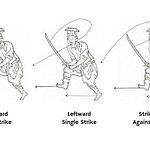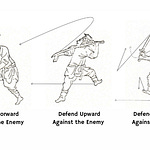In this session, we explore how to initiate the Sword-held Confronting Enemy Dynamic from the ready stance. This marks the beginning of your martial conversation with the opponent — a decisive, composed step forward, both physically and mentally.
1. Transition from Ready Stance
From junbi se (준비세; ready stance):
Grip: Ensure both hands are firmly and evenly spaced along the hilt, creating balance and readiness for swift movement.
Posture: Your spine remains upright, shoulders relaxed, with the blade angled slightly forward. The sword is not passive—it expresses intent.
Focus: Before any physical motion, establish jeongsin (정신; mental presence). The body does not move before the mind.
2. Step into the Confrontation
Begin with the lead foot stepping forward, usually the left. This step should be grounded and deliberate—neither timid nor aggressive.
As the front foot moves, the Ssangsudo is lifted slightly, angling the tip toward the opponent’s upper chest line. Do not overextend.
The rear foot slides smoothly to maintain a low, stable stance with knees slightly bent, allowing immediate movement in any direction.
This step is not an attack but a martial declaration—"I see you, and I am ready."
3. Key Points to Practice
Eye Line and Intention: Do not lower your gaze. Maintain visual contact with the invisible opponent’s chest or upper torso. Your gaze leads your energy.
Weight Distribution: Keep your weight centered and mobile. Avoid leaning forward—this disrupts balance and telegraphs your intent.
Sword Alignment: The blade should not point straight up or down. Let it form a natural angle—diagonally forward, aligned with your centerline, prepared for transition into cut, thrust, or deflection.
4. Common Mistakes to Avoid
Overreaching: A long step that pulls your center too far forward will leave you vulnerable and unable to retreat quickly.
Tension in the Arms: The sword should be an extension of your structure, not a separate burden. Tense arms slow down response and compromise control.
Lack of Purpose: This is not just a step—it is a psychological engagement. Practice with intention.
This dynamic sets the tone for every exchange that follows. You are not yet attacking, but you are no longer neutral. It is the moment your presence fills the space. Train it slowly, repeatedly, and with full awareness.













Share this post